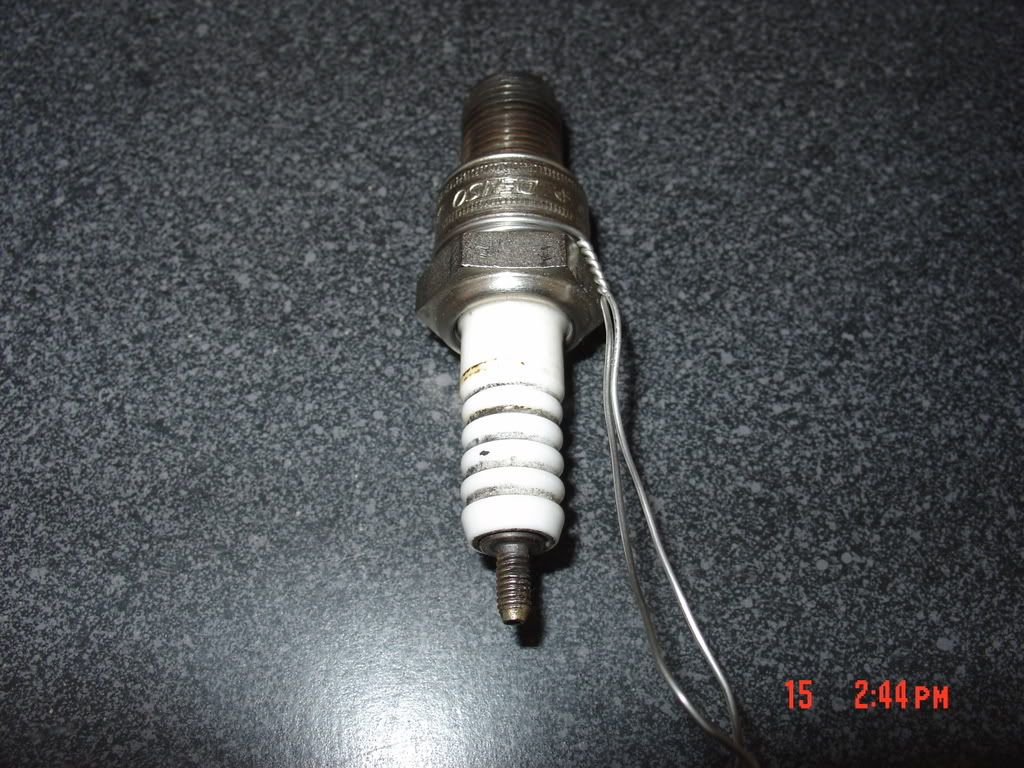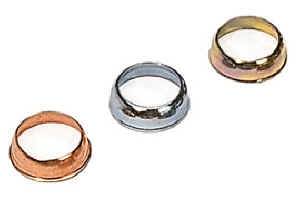Garido wrote:I've been partially dead due to having to relocate house
Here's a couple for a speedy recovery Ray

 "Safety Wire Free" Sump Plug for Sparkley
"Safety Wire Free" Sump Plug for SparkleySump plugs are sometimes required to be
Safety Wired because it seems sump plugs can be challenging to properly keep tight.
My quest is to have a sump plug which needs
no safety wire.
Some configurations of sump plugs need something because they are big diameter heavy plugs hard to torque tighten located low and close to fast moving ground and a head
not projecting down outside or drain
not projecting up inside leaves little room for decent thread locking.
In the past, some manufacturers even used short large steel plugs in very thin large diameter threaded steel nuts requiring extra torque to tighten sweated onto a flimsy housing (sheet metal sump pan) that can't take extra torque...horrific things that still give me nightmares !
Plugs are not joints subject to cyclic load, but more likely subject to vibratory motion of the sump and stress relating to differential expansion and contraction with high sump oil temperature.
Small plugs with long threads in cast alloy housings likely tighten much better. The smaller and lighter the plug and longer the thread the better.
Now linear thermal expansion coefficient of Aluminium Housing is much higher than a Steel Plug and far higher than a Titanium Plug.
The very low expansion and high stiffness of a steel plug (the male) is stretched hard by an alloy housing (the female) countering this is expansion of the female thread diameter exceeding the swelling around the girth of the male plug adding axial clearance in the screw itself.
However this clearance does not appear to be enough in a stiff steel plug to prevent the female maintaining pressure upon the male in a hot embrace.
A titanium plug is just not stiff enough to maintain strong intimate contact along its length to compensate for its lesser ability to swell its diameter on a hot lap.
This all means the steel plug has a significant thread locking safety advantage, thread locking harder with heat than a titanium plug by around 1.47/0.84, a factor of 175% or simply 75% more.

In other words a Steel Plug is a 75% safer plug than a Titanium Plug, ie so much harder to budge when in the thick of a hot lap. Therefore using a steel plug is like adding a "
Steel-Safety Plug" rather than "
Safety Wire".
Because the Titanium Plug has a Temp Tightening Safety Factor less than 100%, or only 84%, that plug would be classified a "
Titanium-Danger Plug".
Of course if we used an aluminium alloy plug having no differential expansion with the sump and therefore no hot lap thread locking, that plug would be classified an "
Alloy-Danger Plug".
Similiarly steel plugs in stamped steel sumps wth no hot lap thread locking can be classified "
Steel-Danger Plugs".
A long history of series and modified production car racing with early large diameter
Steel-Danger Plugs with easily cross threaded fine threads might explain why
Safety Wire was originally mandated for sump plugs left under tightened.
I am therefore thinking of using a Steel-Safety Plug with a plain alloy sealing washer (the standard plug) or alternatively with a
Dowty Sealing Washer if the flat surface at the thread mouth will accommodate.
An aluminium Dowty Sealing Washer uses nitrile rubber sealing which will age so should be replaced every couple of years to keep working effectively.
It provides an additional elastomer seal which will keep sealing at a lower torque than a plain alloy sealing washer (secondary seal for another box to tick in case plug gets under torqued so that elastomer seal friction and resilience might dampen/stop un-torqued plug rotation induced by sump vibration).

I measured a NB8B sump and sump plug at 14 mm x 1.5 mm pitch x 17mm AF on a 21.5 mm diameter head against a 1.5 mm thick plain sealing washer into an alloy threaded boss with 14 mm thread depth with a 29 mm diameter spot face in the lower side of the sump, not underneath it...perfect !

Imagine this Dowty Sealing Washer where D = 22 mm, d1 = 16.4 mm, d = 14.7 mm, s = 1.5 mm seen reflected in this
ebay special.
Alternatively one could stop imagining and think why change something that Mazda seem to have got so right....If it ain't broke....
For example, this alloy housing/Dowty Washer/Steel-Safety Plug system idea is further subject to a
seal temperature risk assessment.
And any Titanium-Danger Plug system is subject to a
thread sticking/galling risk assessment.
In my searching I came across
titanium motor bike plugs with plain sealing washers.
Not sure this is such a good idea...even though 14 mm, I would not be using a rattle gun or hammer to undo a hollowed out alloy or titanium plug done up too tight, even that size.
An alloy or titanium plug would be hard to recover from being stuck too tight, but if it was tough alloy steel...who cares ?...Just hit it harder.
Motor bike alloy and titanium plugs come in fancy colours complete with added lightness and magnetism, but may come with a risk if over tightened.
Interesting to hear from anyone with more experience with them.

With a "Steel-Safety Plug" already "ticking the safety box" as standard, Sparkley is safe without a chemical thread lock on cleaned threads such as "Safety Loctite" or a mechanical restraint like "Safety Wire".

As a point of reference, Sparkley's standard Mazda Steel-Safety Plug system has a tightening torque of 22-30 ft lbs (31-40 Nm) which is say 20% to 30% of proof load for a 14 mm diameter x 1.5 mm pitch Grade 8.8 bolt.
-----------------------------------------------------------------------------------------------------------------------------------------------------------------------------------
Below are my comments posted in an MX5 Parts for Sale Group Buy thread recently and repeated here for posterity.StillIC wrote:sump plugs are the only reasonable place I can think of, off the top of my head...
Fascinating point because plugs are not joints subject to fatigue load, but more likely subject to mechanical vibration of the sump and stress relating to differential expansion and contraction with high sump oil temperature.
If a plug has a large enough length to diameter ratio and a lower Coefficient of Expansion than the Housing it screws into, then it could potentially thread lock as the temperature increases, provided the plug was finally torqued when oil is colder than on hot laps.
Steel and Titanium plugs are obvious options to examine in this respect. In my searching I came across titanium motor bike plugs.
Below is a test of the significance of the relative properties of each plug in this respect.

A titanium plug expands less than a steel plug but steel is much stiffer than titanium, so steel is the safer plug under heat by 1.47/0.84 = 175% safer.
I reckon a TTSF (Temperature Tightening Safety Factor) of 147% is good enough for such a plug to be called a "Steel-Safety Plug" and a TTSF of only 84% for a titanium plug is bad enough to be called "Titanium-Danger Plug".
(100% would be an un-torqued alloy plug in an ally sump or un-torqued steel plug in a steel sump).
That means we can simply start with "Titanium-Danger Plugs" as the base case, adding safety with "Steel-Safety Plugs" substituting for "Safety Wire" in normal "tick the box" risk assessments.
Chemical bonding like Loctite raised by StillIC, seems like a possible option for steel plugs. Maybe not for alloy or titanium plugs because of risk of fracturing an overly tight plug on removal.
Thanks StillIC, I am now inspired to improve that option to something better...a direct replacement for "Safety Wire" called "Safety Loctite".
"Safety Loctite" further provides for a virtual tick of equivalence in the "Safety Wire" tick box, needed to satisfy scrutineers during any transition to the "new normal" of no more Safety Wire.
The Safety Loctite will then be quietly dropped from the check list when mobile mechanics tell authorities they don't get time to wait for the slow drip, drip, drip, drip dripping of sump oil to finally stop oozing out over the threads they keep cleaning.
One thing, we can be sure that "burn risk" safety measures assures us that oil is always changed colder than oil on its hot laps and oil going in is colder than oil coming out.
Therefore "Steel-Safety Plugs" are assured to function as intended, particularly if the final temperature and torque of the plug is the last thing done and recorded with a mislaid pen on that little round sticker stuck to the head of the plug, and shown in a selfie to scrutineers on track day.






















